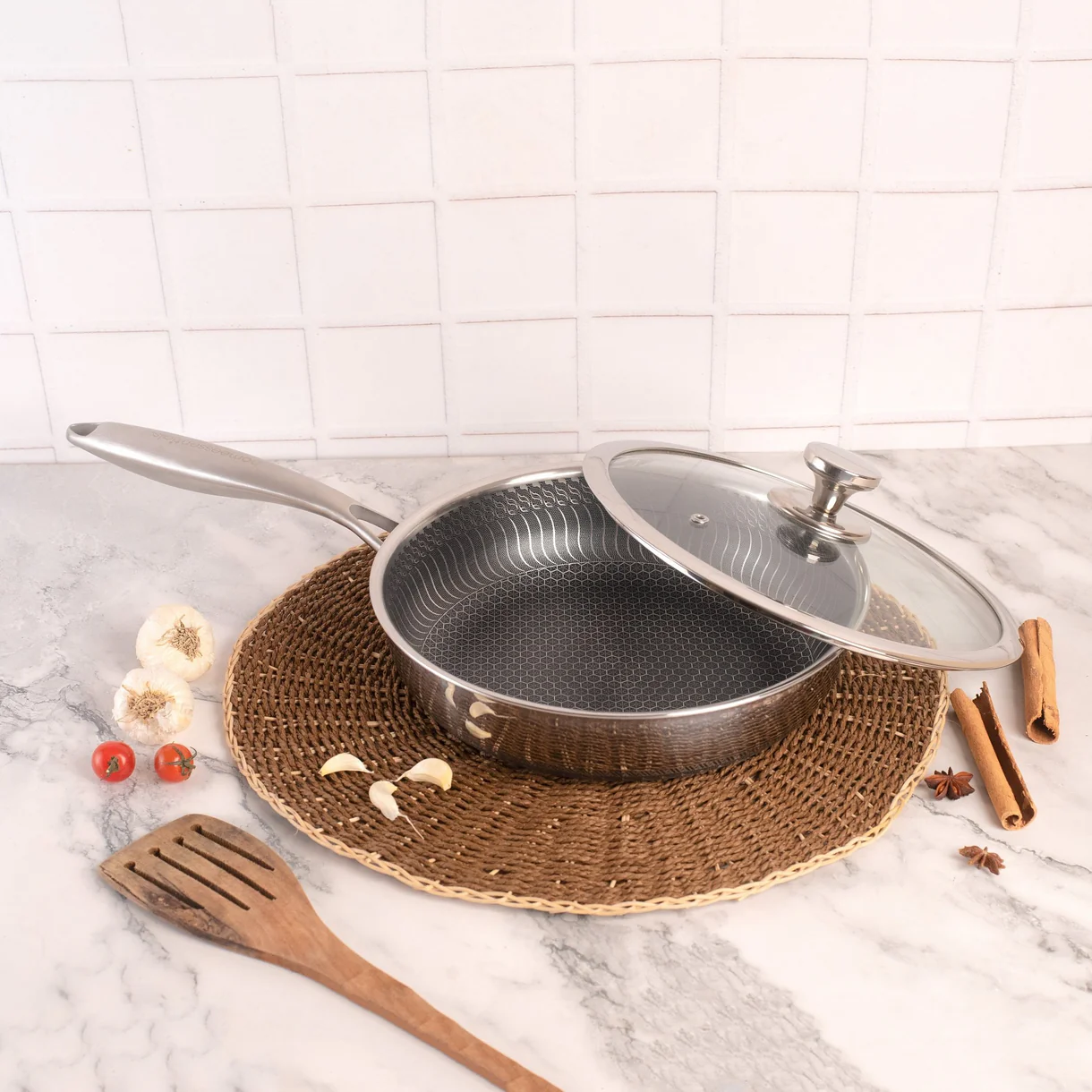
Stainless steel cookware is a smart investment for every home kitchen. It is sleek, sturdy, and built to last years. Unlike coated or reactive surfaces, stainless steel offers a non-reactive surface that keeps your food’s flavour pure, making it a safe cooking material.
The best part? You can use it for a variety of cooking techniques, including searing, sautéing, and simmering. Finally, the polished, mirror-like appearance makes it perfect for modern-day kitchens.
However, many believe that stainless steel is tricky to master. In this article, we will share beginner-friendly tips on how to cook efficiently with the best stainless steel cookware.
1) Understand the Types of Stainless Steel Cookware
Multi-ply construction refers to how many layers of metal are fused. It ensures even heating and prevents food from sticking or burning. Here’s an overview of different multi-ply constructions:
- 3 ply stainless steel cookware: Features 3 alternating layers – stainless steel, aluminum/copper core, and stainless steel base. It distributes heat evenly and prevents hot spots.
- 5 ply stainless steel cookware: Has 5 alternating layers of aluminum/copper and stainless steel. It takes longer to heat but has better heat distribution and retention, making it great for precision cooking in professional kitchens.
- Triply stainless steel cookware: Another word for 3-ply, emphasizing 3 layers fused into one solid piece.
If you are wondering where to find high-quality cookware, look no further. Home Essentials’ stainless steel cookware is a good choice. It is a durable and long-term option for both beginners and experienced cooks. It works on all stovetops, making cooking easy!
2) Season Your Cookware Before First Use
How to use stainless steel cookware for the best results? Season it well. Here’s how to do it:
- Clean the cookware with mild soap and water.
- Dry it thoroughly.
- Heat it gently and coat it evenly with a thin layer of oil.
- Let it cool before wiping off excess oil.
The thin protective layer of oil behaves like a non-stick surface, preventing food from sticking. It also extends the cookware’s life by reducing micro scratches, oxidation, and heat discolouration. Thus, you avoid corrosion and maintain the smooth finish of your cookware.
3) Preheat Your Cookware Properly
Most people wonder how to cook in stainless steel cookware without burning the food. The skill lies in preheating it correctly. To check if your pan is ready, do a simple test:
- Place the pan on medium heat.
- Sprinkle a few drops of water. If they dance and evaporate, you’re good to go.
- If they sit still, wait for a couple more seconds.
- Once it is heated, you will notice how evenly your ingredients cook, especially sautéed vegetables, seared meat, and crispy potatoes.
Pro tip: High heat causes the food to stick and lead to discolouration. So, always use your stainless steel cookware on low to medium heat to preserve its integrity.
4) Use the Right Oils and Cooking Techniques
Some oils cause discoloration or leave a sticky residue behind. Low-smoke oils on high heat also break down quickly, leading to unpleasant flavour. High smoke point oils, like Sunflower, Canola, or Avocado oil, are better suited here. They remain stable under high heat and prevent burnt flavours.
Here’s how to cook in stainless steel cookware with the right oil:
- Pour a small amount of oil into your preheated pan and spread it evenly.
- Wait until it shimmers before adding ingredients.
This allows for even browning and crisp textures, perfect for making stir-fries or searing. Moreover, it ensures that food is evenly cooked and keeps your stainless steel cookware as is.
5) Cleaning and Maintaining Stainless Steel Cookware
Stainless steel is reliable and durable. However, heat, salt and acidic foods can wear it down. Understanding how to use stainless steel cookware, including how to clean and maintain it, will ensure it performs the way it should.
Below are some tips for post-cooking cleanup and maintenance to keep your cookware shiny and scratch-free:
- Avoid harsh abrasives or metal scrubbers. They can dull the finish.
- Wash with warm soapy water and a soft sponge after cooking.
- For burnt residue, soak in baking soda and water for some time before scrubbing.
Stainless steel cookware at Home Essentials is designed for easy cleaning and long-term use, making it a convenient choice for kitchens!
6) Bonus Tip: Combine Stainless Steel with Other Cookware
Stainless steel is versatile. Thus, you can use it alongside cast-iron cookware for specific recipes.
Use stainless steel for searing, boiling, or sautéing, where you need heat control and even cooking. Switch to a non-stick stainless steel cookware or cast iron pans for making eggs and pancakes.
It is wise to create a balanced kitchen setup. Include a mix of high-quality stainless steel and non-stick pans from Home Essentials cookware. It gives you the freedom to use multiple cooking techniques and try new dishes with ease and comfort. Moreover, it makes your kitchen more efficient.
Conclusion: Mastering the Art of Cooking with Stainless Steel
Remember to preheat, season, and clean your best stainless steel cookware correctly. Use the right oils and maintain low to medium heat while cooking to maintain their quality and longevity. Like any skill, mastering stainless steel takes a few tries. But once you do, it becomes one of the most rewarding cookware types.
Explore premium stainless steel cookware at Home Essentials for durable, long-lasting options to elevate your cooking experience.